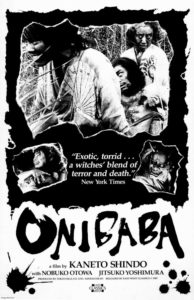 One of the all-time classics of Japanese horror, ONIBABA is a stunningly photographed, deeply stylish film. Much of the shock value that made this film’s initial reputation has worn off, but it remains a singularly horrific glimpse into humanity’s darkest depths.
One of the all-time classics of Japanese horror, ONIBABA is a stunningly photographed, deeply stylish film. Much of the shock value that made this film’s initial reputation has worn off, but it remains a singularly horrific glimpse into humanity’s darkest depths.
ONIBABA is a stunningly photographed, deeply stylish film.
Director Kaneto Shindo is one of Japan’s most prolific filmmakers, having made over sixty films, of which 1964’s ONIBABA is probably the most famous. Its full frontal female nudity and graphic sexuality were unprecedented (it was produced by Shindo’s own production company Kindai Eiga Kyokai, exempting it from the repressive standards adhered to by most Japanese films of the time) and cleared the way for envelope-pushing classics like MOJU (BLIND BEAST; 1968) and AI NO CORRIDA (IN THE REALM OF THE SENSES; 1976). ONIBABA’S success inspired a follow-up, KURONEKO (1967), about a mother and daughter who are raped and murdered but come back as somersaulting cat women to torment their killers. My verdict on KURONEKO: strikingly photographed, but it suffers from an overabundance of sentimentality and a severe underabundance of character development.
Director Kaneto Shindo is one of Japan’s most prolific filmmakers, having made over sixty films, of which 1964’s ONIBABA is probably the most famous.
ONIBABA’S source material is a Buddhist fable (helpfully included in the supplemental material on Criterion’s ONIBABA DVD) about a young widow living with her spiteful mother in law; the older woman tries to stop her young companion from going to worship by scaring her with a demon mask, but Buddha punishes the hag by making the mask stick to her face. Only when she gives Buddha her full respect does the mask come off and the women live happily ever after. Kaneto Shindo made some perverse changes to the fable in ONIBABA: here the old woman puts on the mask to stop her young charge from rushing off to have sex…and prayer doesn’t help in removing the mask, which when it finally comes off takes much of the wearer’s face with it!
An old woman and her young stepdaughter are living in Sixteenth Century Japan, a time of ceaseless warfare. They subside by luring wandering samurai into a deep pit, where they fall and die, after which the women strip the armor from the bodies and sell it. Awaiting the return from war of their respective spouses, they’re befriended by a strapping young man who starts up a tryst with the young woman, much to the consternation of her stepmother.

When a samurai wearing a demon mask shows up one day, the old woman lures him to the hole, where he falls to his death, and steals the mask. She then takes to wearing the mask and scaring her stepdaughter each night in order to keep her from her lover. Unfortunately, it rains one night, causing the mask to stick to the old woman’s face. With the understandably peeved younger woman’s help, the mask is wrenched off, leaving behind a bloody and deformed face even more demonic-looking than the mask itself. Horrified, the young woman runs off. The old woman gives chase, and ends up falling into the very hole where so many of her victims met their deaths.
Kaneto Shindo’s virtuoso widescreen compositions remain unsurpassed, bolstered by Kiyomi Kuroda’s stark black and white photography, which makes excellent use of light and shadow. The music by Hikaru Hayashi is equally effective, with its loud, primal use of screaming voices and clattering drums, a perfect compliment to the frenzied passion and violence of Shindo’s imagery.
Kaneto Shindo’s virtuoso widescreen compositions remain unsurpassed, bolstered by Kiyomi Kuroda’s stark black and white photography, which makes excellent use of light and shadow.

ONIBABA’S setting is what really singles it out as a unique work of art (Shindo served as his own art director, and so deserves full credit for the scenery): a sea of tall, drifting reeds as striking—and unaccountably eerie—as anything I’ve seen in any movie. In this dark, surreal landscape that undulates, seemingly with the passions of its inhabitants, it’s entirely believable that demons are afoot…but of course, as the ending makes clear, the real demons lurk solely within the hearts and minds of the central characters.
Vital Statistics
ONIBABA
Toho International Co./Kindai Eiga Kyokai
Director: Kaneto Shindo
Screenplay: Kaneto Shindo
Cinematography: Kiyomi Kuroda
Editor: Toshio Enoki
Cast: Nobuko Otowa, Jitsuko Yoshimura, Kei Sato, Jukichi Uno, Taji Tonoyama
